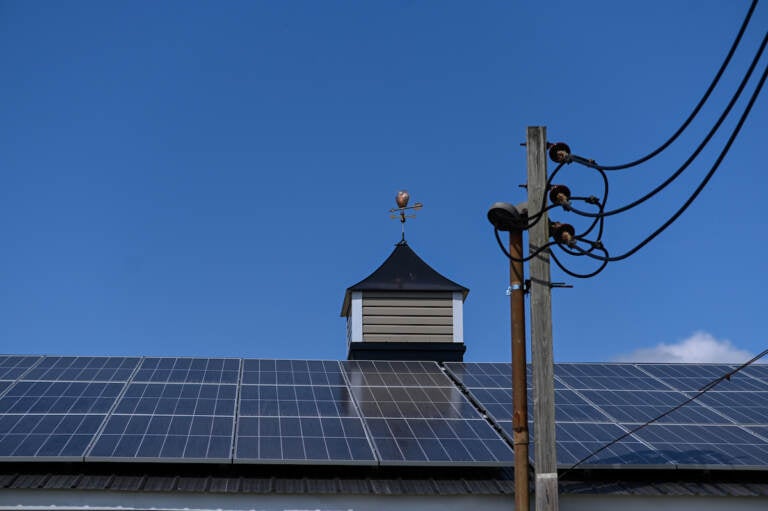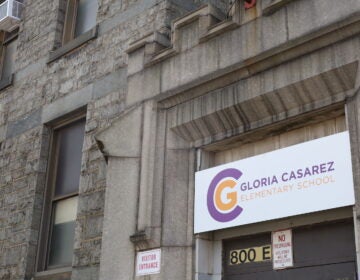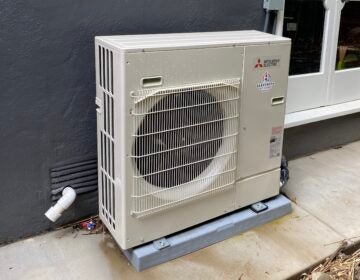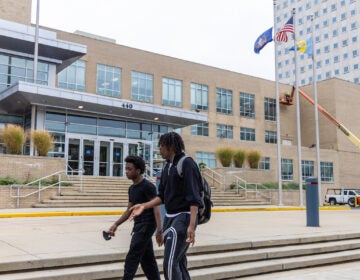New state grant program means solar panels could bring deeper savings to cash-strapped Philly schools
The cash-strapped district expects to be eligible to apply for Solar for Schools grants and is currently working to identify good sites for solar.
Listen 1:11
A solar array at Maple Lawn Farms in York County on Sept. 20, 2022. (Jeremy Long/WITF)
This story is part of the WHYY News Climate Desk, bringing you news and solutions for our changing region.
From the Poconos to the Jersey Shore to the mouth of the Delaware Bay, what do you want to know about climate change? What would you like us to cover? Get in touch.
As the school year kicks off, many Philadelphia students are returning to aging buildings that are powered by an electric grid fueled largely by planet-warming natural gas.
But that could change in the coming years. Solar for Schools, a state grant program currently under development, aims to launch Pennsylvania schools into a climate-friendly future by subsidizing the cost of rooftop solar panels.
“The grant program honestly is a huge breakthrough,” said Liz Robinson, director of the Philadelphia Solar Energy Association, which developed a toolkit to help schools go solar. “Our schools need more money, and one huge way to do that is by reducing their energy costs.”
The program could mean not only greener schools, but also savings for the historically underfunded School District of Philadelphia, according to an analysis by the Philadelphia Energy Authority.
State grants to leverage federal tax incentives
The Solar for Schools program was created by a bill Gov. Josh Shapiro signed in July and funded with $25 million of state money in this year’s budget.
The program will provide grants covering up to half the costs of solar energy equipment and installation.
It’s meant to help schools make the most of federal tax credits made available to public institutions like schools under the 2022 Inflation Reduction Act. These can reimburse districts for up to 30% or 50% of the cost of solar projects, based on factors such as their location in a low-income community or an “energy community,” which is defined by unemployment rates and the presence of brownfield sites, retired coal mines or coal-fired power plants.
“It’s a no-brainer at that point,” Robinson said. “It’s incredibly cost-effective.”
Districts cannot apply for the state Solar for Schools grants yet. The state Department of Community and Economic Development has until mid-October to work out the details of the program.
Under the Solar for Schools legislation, the funding will be split up into three regions of the state, meaning Philly schools will be competing against neighboring districts for a pot of roughly $8 million.
Potential savings for Philly schools
This spring, Philadelphia City Council passed a resolution supporting Solar for Schools, saying it would “save schools money on fluctuating and rising energy costs.”
Staff at the quasi-governmental Philadelphia Energy Authority crunched the numbers and say it’s true: At certain Philly schools, solar projects utilizing the federal credits and new state grants would not only pay for themselves, but put savings back into the district’s coffers.
The Philadelphia Energy Authority analyzed hypothetical rooftop solar projects that would cover part of the electricity usage at Mayfair Elementary School, Furness High School and Dobbins Technical High School. The authority found that, with the federal reimbursement alone, the projects would deliver electricity to the schools for cheaper than they would buy it from the grid.
The projects would pay for themselves over the course of 20 years, delivering on average tens of thousands of dollars in savings to the district each year, the authority claims.
That means if the district were to receive Solar for Schools grant money, the projects would produce even more savings.
“It’s really hard to not see the value in stacking those discounts,” said Katie Bartolotta, the agency’s vice president of policy and strategic partnerships. “You’re paying very little for a system that’s going to keep yielding annual savings in your electricity costs long-term.”
The district could invest those savings into other needed building renovations, Bartolotta said.
The School District of Philadelphia could potentially get up to 90% of the costs of a solar project covered if it were to receive the competitive federal reimbursement for location in a low-income community and the maximum Solar for Schools grant.
What’s more, the Solar for Schools program allows districts to finance the projects using the state’s Guaranteed Energy Savings Act (GESA), which lets districts and local governments pay for projects using the resulting utility cost savings without needing an up-front allocation.
Robinson said that even before the new federal incentives and the forthcoming state grants, solar power was financially feasible for some Pennsylvania school districts through power purchase agreements. She points to a small district in Dauphin County that expects to save over $1 million over the course of 20 years from a 2019 solar project on a nearby landfill.
Spokesperson Christina Clark said the School District of Philadelphia expects to be eligible to apply for Solar for Schools grants and is currently working to identify sites with electrical systems, roof conditions and available space that could accommodate solar panels.
The district has already used the GESA financing model to make close to $276 million worth of investments in ventilation, air conditioning and lighting at schools in recent years — projects that have so far saved the district over $1 million, Clark said.
The district says it has roughly $7 billion in capital needs.

Get daily updates from WHYY News!
WHYY is your source for fact-based, in-depth journalism and information. As a nonprofit organization, we rely on financial support from readers like you. Please give today.









